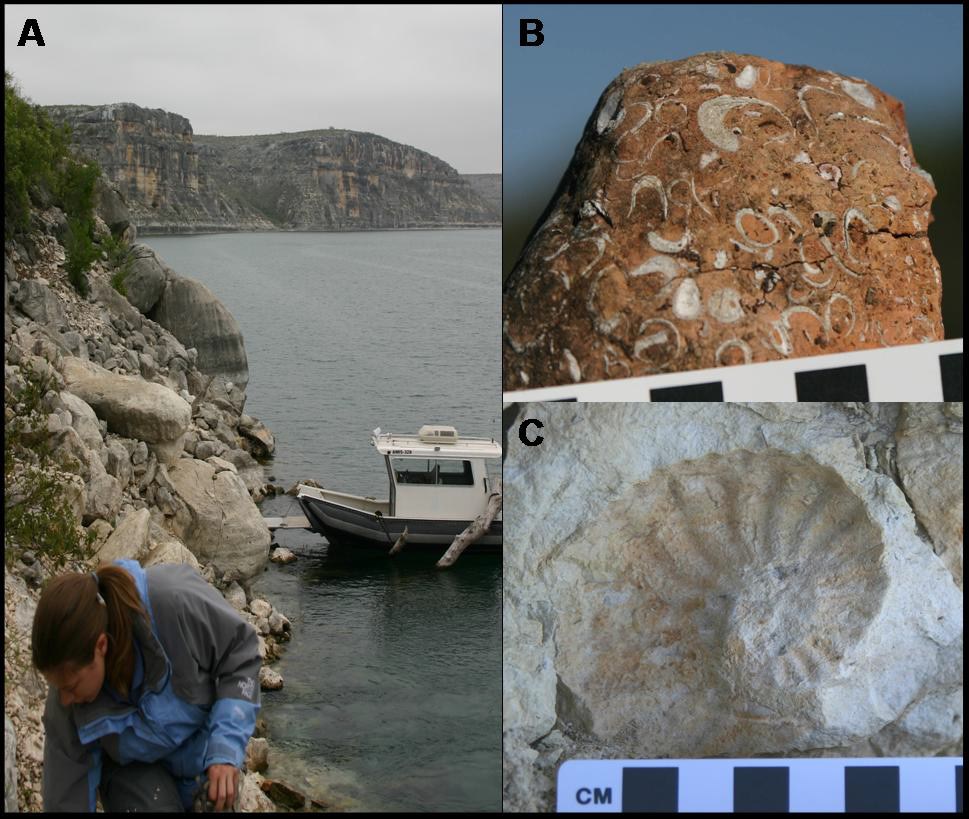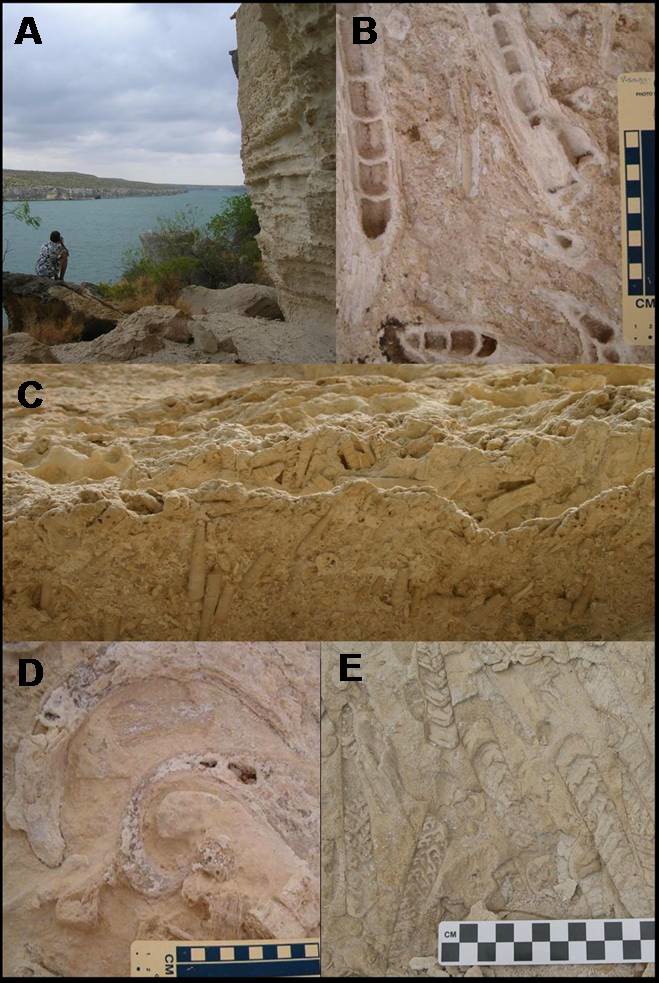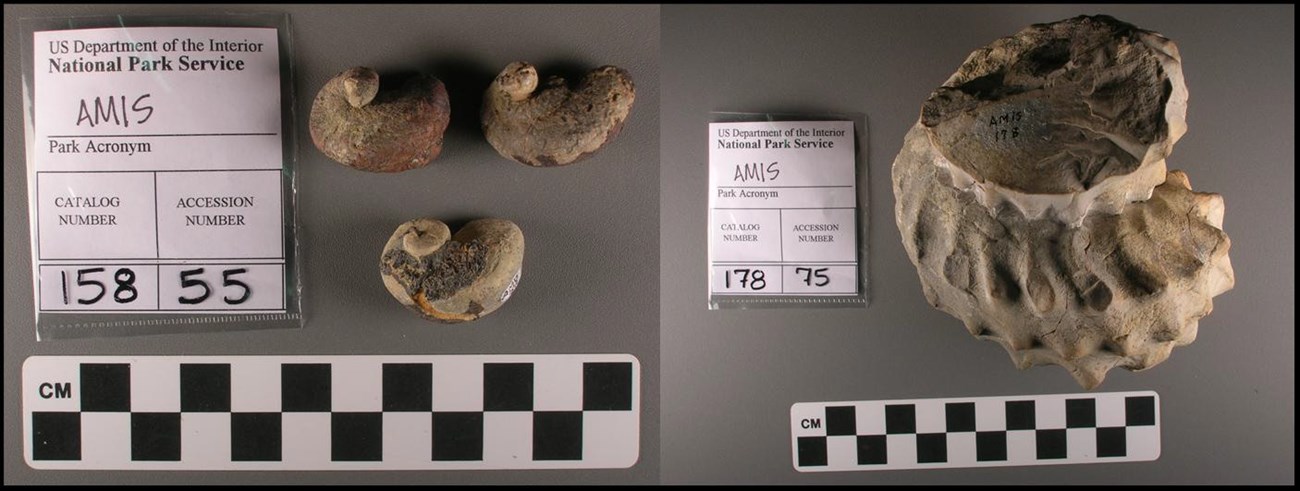Part of a series of articles titled Park Paleontology News - Vol. 13, No. 2, Fall 2021.
Article
A Paleontological Survey at Amistad National Recreation Area: Swimming in the Mesozoic and Hunting in the Quaternary

Christy C. Visaggi, Paleontologist
Georgia State University
The grand cliffs that bound Amistad National Recreation Area (AMIS) contain diverse and abundant paleontological resources. Fossils are represented by vertebrates, invertebrates, microfossils, plants, and trace fossils extending back more than 100 million years. Prior to conducting a NPS paleontological resource survey at AMIS in March of 2006, not much was known regarding the paleontology of the park. What constitutes a NPS paleontological resource survey? They are on-site investigations that include an in-depth analysis of park geology, fossiliferous localities, museum collections, and interpretive programs. An inventory of park fossils is additionally completed and recommendations concerning management of park paleontological resources are offered. These surveys yield comprehensive reports that build upon existing summaries created for Inventory & Monitoring Networks. My fieldwork for the survey at AMIS covered 25 in-park localities, eight Val Verde County road-cuts, two neighboring sites on private land, and the nearby Seminole Canyon State Park. This article discusses a few of the paleontological highlights from this survey.

Figure 1. Sample of AMIS fossil resources. A) The author explores Salmon Peak Limestone along the Devils River. B) Fire-cracked rock full of Ilymatogyra arietina oysters found inside the park. C) Ammonite impression exposed in Buda Limestone.
Photos by Jack Johnson. Modified from Visaggi et al. (2009).
Marine life flourished in southwest Texas during the Cretaceous Period of the Mesozoic Era. Much of America’s heartland was covered by an ancient seaway full of foraminifera, bryozoans, bivalves, gastropods, ammonoids, and echinoids, many of which are preserved in the rocks at AMIS. Shallow marine reefs consisting primarily of large rudistid bivalves from the Lower Cretaceous Devils River Limestone comprise the oldest deposits mapped inside the park (over 100 million years old). This formation stretches along the Rio Grande from western Texas to the Pecos River (Smith et al. 2000), upon which some of the most complete exposures of Lower Cretaceous rock are found in North America (Kerans et al. 1995). The slightly younger and in part equivalent Salmon Peak Limestone is similarly exposed in the eastern portion of the park. These units are unconformably overlain by rocks of the Upper Cretaceous including the Del Rio Clay, Buda Limestone, and Boquillas Formation. The Del Rio Clay contains deposits that are richly populated by Ilymatogyra arietina, an oyster that is sometimes referred to as the “Devil’s Toenail” due to its characteristic curled shell. The Buda Limestone rests unconformably on this unit and represents a shift to deeper waters as evidenced by the increased abundance of ammonoids in this deposit. The youngest unit from the Cretaceous confirmed within AMIS is the fine-grained Boquillas Formation, continuing the trend to increasingly deep offshore deposition. Although the mass extinction at the end of the Cretaceous is not preserved in the exposures at AMIS, several of the key fossil groups reported inside the park such as ammonoids and rudistid bivalves perished at the end of the Mesozoic Era. Examples of these fossils and exposures at AMIS are featured in Figures 1 & 2.

Figure 2. Salmon Peak Limestone. A) Fossiliferous bluffs on the Rio Grande. Jack Johnson for scale. B) Exposed interiors of rudistid bivalves. C) Terraces carved by aeolian erosion. D) Rudistid bivalves. E) Vertical cross-sections of Nerinea gastropods.
Photos by Angel Johnson (A), Christy Visaggi (B, D), and Jack Johnson (C, E). Modified from Visaggi et al. (2009).
Cenozoic deposits mapped inside park boundaries comprise the Plio-Pleistocene Uvalde Gravel, river terraces of the Pleistocene, and organic-bearing alluvium from the Holocene. These units are not commonly reported as fossiliferous; however, cultural deposits which often contain faunal and floral remains can be found among terrace and alluvial sediments in the AMIS vicinity (Anderson 1974). These relatively recent paleontological resources of the Pleistocene and Holocene are frequently uncovered in rock shelters formerly utilized by indigenous people of the Chihuahuan Desert. NPS archeological excavations prior to the construction of the Amistad Reservoir encountered a variety of Pleistocene megafauna in their deep strata, such as mammoth, bison, horse, camel, antelope, mountain deer, and short-faced bear (although only the bison remains from Bonfire Shelter show clear evidence of human involvement). Holocene cultural deposits may include middens, hearths, and burials, many of which contain some combination of bones, shells, pollen, and plant fibers. Paleontological resources found in a cultural context serve as indicators of ancient behavior and diet. The progression of bison hunting methods in the region and the use of fossiliferous “fire-cracked” rock in hearths for plant baking as the region became more arid are of particular interest when studying the activities of former inhabitants of the Lower Pecos. Specimens preserved in cultural deposits are often additionally utilized for interpreting changes in local vegetation and paleoclimate throughout the Quaternary.
The 2006 survey focused on Cretaceous fossils, as numerous publications already describe Quaternary biota unearthed during archeological investigations in and around AMIS (for a review see Dering 2002). Several fossils from the Mesozoic recovered inside park boundaries were accessioned in the collections as a result of fieldwork from the 2006 survey. Specimen records for pre-existing collections were updated. The AMIS collections are very large, with more than one million cataloged objects, and although the percentage of those cataloged as paleontological is minor, archeological collections incorporate many paleontological resources from the Quaternary. Example fossils in the collections from Cretaceous deposits in the park are featured in Figure 3.

Figure 3. Sample of fossils within Amistad National Recreation Area museum collections. Left: Ilymatogyra arietina oysters showing chemical alteration. Right: A partial ammonite, Plesioturrilites sp., from Cretaceous deposits.
Photos by Jack Johnson. Modified from Visaggi et al. (2009).
Interpretation at AMIS mainly focuses on the archeology of the region; opportunities to increase paleontological programs at the park are plentiful. Improved fossil collections and documentation of localities provide a strong foundation for the future of paleontology at AMIS. There are a number of threats to in situ fossil resources at AMIS such as unstable strata, erosion, flooding, development, theft, and vandalism. It is important to recognize any dangers to paleontological resources so that they can be managed effectively. One new wayside was already installed on a park trail as a result of the work in this survey. AMIS is full of paleontological surprises that are still waiting to be uncovered. While most park visitors enjoy the park for its renowned rock art or as a nationwide hot spot for bass fishing, as a paleontologist, I know that at AMIS I prefer to swim in the Mesozoic and hunt in the Quaternary instead!
Related Links
- Amistad National Recreation Area, Texas—[Geodiversity Atlas] [Park Home]
- NPS—Fossils Through Geologic Time
- NPS—Fossils and Paleontology
- NPS—Geology
Last updated: September 29, 2021
